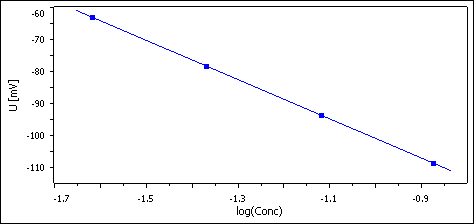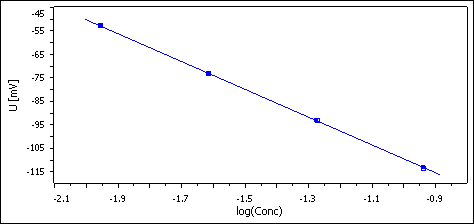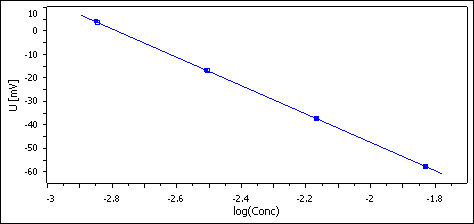This article explains how the fluoride ion-selective electrode (ISE) can be effectively used to make several fluoride determinations in different kinds of matrices.
Choice of Procedure
The number of samples to analyze, the sample matrix, and the concentration range of the sample decide the choice of the procedure.
- To quantify samples with an unknown or complex matrix, the standard addition provides the best solution. However, a direct measurement is suggested in the case of an uncomplicated sample matrix.
- The direct measurement is suggested for online measurements or large sample numbers.
- For low-level measurements, either direct measurement can be made following calibration, or the sample can be spiked to a higher content. This is because the sensor is at the limit of detection and is beyond its linear range, which results in too high results in the standard addition approach.
Sample Preparation and Parameter
The sample preparation and the parameters are described in the Practical Examples section.
Direct Measurement
Direct measurement is suggested for uncomplicated samples and in the case of low-level measurements (µg/L or mg/L range). For a direct measurement, the following points should be taken into consideration:
- For less than 1 mg/L concentrations, the standard solutions should have the same ionic background as that of the sample solutions. The response time of the sensor becomes markedly longer. For these measurements, a TISAB:water ratio of 1:1 should be utilized.
- All measurements must be conducted at constant temperatures (for instance, at 25 °C)
- Both the pH value and the ionic strength are kept constant by adding the TISAB solution prior to the measurement. The TISAB solution has the supplementary effect of binding the interfering cations and thus releasing complexed fluoride.
Standard Addition
Standard addition is suggested for complex or undefined sample matrices. Three types of standard addition are available:
Automatic standard addition (mode: “auto”) is the quickest and recommended technique. To obtain accurate results, the potential difference (DU) must be at least 12 mV for each standard addition, and a minimum of three standard additions should be carried out (total DU at least 36 mV).
The mode “auto dos” is suggested for users requiring precisely defined amounts of the standard additions, while desiring maximum ease of operation. In this case, users can define the individual standard addition volumes (refer to the manual of the device in use or the online help of the software).
The concentration of the standard or the amount of the added solution should be selected such that the dosed volume does not surpass 25% of the volume of sample and that the buret should not be refilled during addition. The result is automatically calculated by the instrument through an iteration procedure.
The following points should be considered in the case of standard addition:
- Stirring should be done during additions. If continuous stirring is not done during additions, it may lead to false results.
- The pH value and the ionic strength can be kept constant by adding the TISAB solution prior to the measurement. The TISAB solution has the supplementary effect of binding the interfering cations and thus releasing complexed fluoride.
- If the overall volume added at the time of standard addition turns out to be greater than 10% of the initial solution, the standard should be dissolved in the TISAB solution.
- To guarantee a precise assessment of the standard addition, the standard concentrations (cstd) for the different volumes of buret (Vburet/mL) should be selected as a function of the sample concentration (csmpl) in accordance with the table shown below. Hence, any sample dilution should be taken into consideration (for example, dilution with the TISAB solution).
Table 1. Ratio of the standard concentration and sample concentration in dependency of the buret volume.
| Vburet in mL |
cstd : csmpl |
| 5 |
40 : 1 |
| 10 |
20 : 1 |
| 20 |
10 : 1 |
| 50 |
5 : 1 |
Example Factor Determination
- Sample concentration (csmpl)—5 mg/L
- Buret volume (Vburet)—10 mL
- Sample size—10 mL
- TISAB—10 mL
- Total volume (Vtotal)—20 mL
- Factor from Table 1 (cstd:csmpl)—20
Considering the dilution with the TISAB solution, the initial concentration of the sample is 2.5 mg/L. Therefore, the optimal concentration of the standard is 2.5 mg/L⋅20 = 50 mg/L.
Comments
Titration by lanthanum nitrate is a conventional analysis method. However, lanthanum produces complexes with ingredients and buffers of the TISAB solution and samples. This leads to excess usage of titrant and a too high result. Hence, the titration of fluoride with lanthanum nitrate is not suggested.
Practical Examples
Reagents
The following reagents are required to prepare the fluoride standard and Total Ionic Strength Adjustment Buffer IV (TISAB IV):
- Sodium chloride, NaCl ≥ 99.5%
- Sodium fluoride, NaF > 99%
- Sodium hydroxide, c(NaOH) = 8 mol/L
- Glacial acetic acid
- Complexon IV (1,2 di-amino cyclohexane N,N, N′,N′ tetraacetic acid)
Solutions
- All solutions should be preserved in plastic containers. This is because the fluoride content of sample solutions stored in glass containers decreases with time.
- The solutions—standard, sample, and TISAB solution—should not be preserved more than three months. A low electrode slope can indicate the poor quality of the solutions.
Table 2.
| . |
. |
| Fluoride standard |
ß(F-) = 1 g/L
2.210 g of NaF is initially weighed into a 1-L volumetric flask and the precise weight is noted down. Then, the NaF is dissolved in deionized water (H2O) before the flask is filled up to the mark with the same. |
| TISAB IV |
First, 58 g of NaCl is dissolved in about 500-mL deionized H2O, and then 5 g of complexon IV is added and dissolved by adding c(NaOH) = 8 mol/L in a drop-wise manner. Then, 57-mL glacial acetic acid is added to the mixture and its pH is altered to 5.5 with the aforementioned NaOH solution. Lastly, it is made up to 1 L with deionized H2O. The TISAB solution is used to analyze table salt, toothpaste, and mouth rinse. |
| Further TISABs |
The required TISAB is mentioned separately for other applications. |
Fluoride in Table Salt by Means of Direct Measurement
Sample
- Table salt, fluoride content of 50 mg/L
Solutions
- TISAB IV
- Fluoride standard (1 g/L)
- Sodium chloride solution, β(NaCl) = 200 g/L
Sample Preparation
First, 20 g of table salt is weighed into a 100-mL volumetric flask and subsequently dissolved in 50-mL deionized H2O. The same deionized H2O is used to fill the flask up to the mark.
Standard Preparation
Table 3.
| Standard |
1 |
2 |
3 |
4 |
| Concentration/(mg/L) |
25 |
50 |
75 |
100 |
To prepare the calibration standards, the fluoride standard (1 g/L) was diluted to the required concentrations.
Analysis
Calibration
At first, 10 mL of TISAB IV and 10 mL of sodium chloride solution are added to 20 mL of standard solution (for concentrations, refer to standard preparation). The solution is then stirred and the potential is quantified after a brief pause. Between every measurement, the electrode is conditioned in TISAB IV/deionized H2O (1/1) for 5 minutes.
Sample
First, 10 mL of deionized H2O and 10 mL of TISAB IV are added to 20 mL of sample solution, and the potential is quantified after a brief gap. Between every measurement, the electrode is conditioned in TISAB IV/deionized. H2O (1/1) for 5 minutes.
Parameters
Calibration
Table 4.
| . |
. |
| Mode |
CAL MEAS Conc |
| Stirring rate |
6 |
| Signal drift |
0.5 mV/minute |
| Minimum waiting time |
10 seconds |
| Maximum waiting time |
215 seconds |
Sample
Table 5.
| . |
. |
| Mode |
MEAS Conc |
| Stirring rate |
5 |
| Signal drift |
0.5 mV/min |
| Minimum waiting time |
10 seconds |
| Maximum waiting time |
215 seconds |
Results
Calibration
Measured values
Table 6.
| Standard |
Concentration/(g/L) |
U/mV |
| 1 |
0.025 |
47.8 |
| 2 |
0.050 |
30.1 |
| 3 |
0.076 |
20.3 |
| 4 |
0.101 |
12.9 |
- Slope: −57.40 mV
- E(0): −44.2 mV
- c(blank): 0.00 mg/L
- Variance: 0.195
Sample
Table 7.
| . |
. |
| Sample |
Concentration/(mg/L) |
| Mean (n = 3) |
43.17 |
| s(rel) |
0.53% |
Example Determination
Calibration

Figure 1. Calibration curve. Image Credit: Metrohm AG
Comments
The use of a NaCl solution for the calibration is needed to achieve the same ionic background between the sample measurement and calibration.
Fluoride in Table Salt with Automatic Standard Addition
Sample
- Table salt, fluoride content of 50 mg/L
Solutions
- TISAB IV
- Fluoride standard (1 g/L)
Sample preparation
First, 20 g of table salt is weighed into a 100-mL volumetric flask and then dissolved in 50-mL deionized H2O. The same deionized H2O is used to fill the flask up to the mark.
Analysis
Initially, 10 mL of the sample solution (dilution factor 10), 5 mL of deionized H2O, and 5 mL of TISAB IV are pipetted into the measuring vessel. The standard addition is performed with β(F−) = 1 g/L. Between every measurement, the electrode is conditioned in TISAB IV/deionized H2O (1/1) for 5 minutes.
Parameters
Table 8.
| . |
. |
| Mode |
STDADD auto |
| Stirring rate |
5 |
| Number of additions |
3 |
| Volume of auxiliary solution |
10 mL |
| Stop volume |
10 mL |
| Dosing rate |
Medium |
| Delta U |
15 mV |
| Signal drift |
0.5 mV/minute |
| Maximum waiting time |
215 seconds |
Calculation
The result is automatically calculated by the instrument through an iteration process.
Results
Table 9.
| Increment |
dV/mL |
U/mV |
dU/mV |
| 0 |
/ |
-63.1 |
/ |
| 1 |
0.391 |
-78.5 |
-15.4 |
| 2 |
0.736 |
-93.8 |
-15.3 |
| 3 |
1.403 |
-108.9 |
-15.1 |
- Slope: −61.46 mV
- E(0): −162.53 mV
- F(−1): 0.0483 g/L
- Variance: 0.003
Example Determination

Figure 2. Curve of the standard addition for table salt. Image Credit: Metrohm AG
Fluoride in Mouth Rinse with Automatic Standard Addition
Sample
- Mouth rinse, fluoride content of 220 mg/L
Solutions
- TISAB IV
- Fluoride standard (1 g/L)
Sample preparation
Sample preparation is not needed.
Analysis
First, 1 mL of sample, 10 mL deionized H2O, and 10 mL of TISAB IV are pipetted into the measuring vessel, and the standard addition is performed with β(F−) = 1 g/L. Between every standard addition, the electrode is conditioned in TISAB IV/deionized H2O (1/1) for 5 minutes.
Parameters
Table 10.
| . |
. |
| Mode |
STDADD auto |
| Stirring rate |
5 |
| Number of additions |
3 |
| Volume of auxiliary solution |
20 mL |
| Stop volume |
10 mL |
| Dosing rate |
Medium |
| Delta U |
20 mV |
| Signal drift |
0.5 mV/minute |
| Maximum waiting time |
215 seconds |
Calculation
The result is automatically calculated by the instrument through an iteration procedure.
Results
Table 11.
| Increment |
dV/mL |
U/mV |
dU/mV |
| 0 |
/ |
-52.7 |
/ |
| 1 |
0.285 |
-73.1 |
-20.4 |
| 2 |
0.652 |
-93.3 |
-20.2 |
| 3 |
1.541 |
-113.4 |
-20.1 |
- Slope: −59.62 mV
- E(0): −169.29 mV
- F(−1): 0.2331 g/L
- Variance: 0.008
Example determination

Figure 3. Curve of the standard addition for a mouth rinse. Image Credit: Metrohm AG
Fluoride in Toothpaste with Automatic Standard Addition
Sample
- Toothpaste, fluoride content of 1300 g/kg
Solutions
- TISAB IV
- Fluoride standard (1 g/L)
- Hydrochloric acid, concentrated HCl
Sample preparation
Initially, 5 g of sample is weighed into a 100 mL beaker, and 5 mL concentrated HCl and 5 mL of deionized H2O are added to the sample and homogenized by stirring for 60 seconds. Then, the beaker is placed into a water bath for 1 minute at 90 °C. After the solution is cooled down to room temperature, it is transferred to a 1000 mL volumetric flask and filled up to the mark with deionized H2O.
Analysis
First, 20 mL of TISAB IV and 5 mL of the sample solution, with a dilution factor of 200, are pipetted into a measuring vessel, and then the standard addition is performed with β(F−) = 1 g/L. Between every standard addition, the electrode is conditioned in TISAB IV for a period of 5 minutes.
Parameters
Table 12.
| . |
. |
| Mode |
STDADD auto |
| Stirring rate |
5 |
| Number of additions |
3 |
| Volume of auxiliary solution |
20 mL |
| Stop volume |
10 mL |
| Dosing rate |
Medium |
| Delta U |
20 mV |
| Signal drift |
0.5 mV/minute |
| Maximum waiting time |
215 seconds |
Calculation
The result is automatically calculated by the instrument through an iteration procedure.
Results
Table 13.
| Increment |
dV/mL |
U/mV |
dU/mV |
| 0 |
/ |
3.7 |
/ |
| 1 |
0.043 |
-16.9 |
-20.7 |
| 2 |
0.093 |
-37.3 |
-20.4 |
| 3 |
0.204 |
-57.8 |
-20.5 |
- Slope: −60.47 mV
- E(0): −168.43 mV
- F(-1): 1.4234 g/kg
- Variance: 0.005
Example Determination

Figure 4. Curve of the standard addition for mouth rinse. Image Credit: Metrohm AG
Sources and Further Reading
- Metrohm Monograph Electrodes in Potentiometry, 8.015.5013
- Manual Ion-selective electrodes (8.109.1476)
- AOAC method 973.10, Fluoride in hazardous substances. Potentiometric method. AOAC, 1990, 1, 232-233.
- AOAC method 975.04, Fluoride in plants. Potentiometric method. AOAC, 1990, 1, 51-52.
- Jordan, D. Determination of total fluoride and/or fluosilicic acid concentration by specific fluoride ion electrode potentiometry J. Assoc. Off. Anal. Chem., 1970, 53, 3, 447-450.
- Singer. L.; Armstrong, W.D. Determination of fluoride in bone with the fluoride electrode Anal. Chem., 1968, 40, 3, 613-614.
- Abollino, O., Mentasi, E., Sarzanini, C., Modone, E., Braglia, M., Determination of Zr, Ba, La, Al, Na, Hf and fluoride in fluorozirconate glasses. Fresenius J.Anal. Chem., 1992, 343, 6, 482-487.
- Langenauer, M., Krähenbühl, U., Wyttenbach, A. Determination of fluorine and iodine in biological materials Anal. Chim. Acta, 1993, 274, 2, 253-256.
- Edmond, C.R. Direct determination of fluoride in phosphate rock samples using the specific ion electrode. Anal. Chem, 1969, 41, 10, 1327-1328.
- McQuaker, N.R., Gurney, M. Determination of total fluoride in soil and vegetation using an alkali fusion-selective ion electrode technique. Anal. Chem, 1977, 48, 1, 53-56.

This information has been sourced, reviewed and adapted from materials provided by Metrohm AG.
For more information on this source, please visit Metrohm AG.